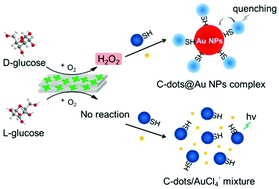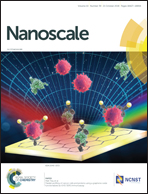A chiral responsive carbon dots–gold nanoparticle complex mediated by hydrogen peroxide independent of surface modification with chiral ligands†
Abstract
Chiral recognition of enantiomers is fundamentally important. In this study, a novel strategy for the chiral discrimination of glucose enantiomers was constructed based on the hydrogen peroxide (H2O2)-mediated generation of a carbon dots–gold nanoparticle (C-dots@Au NP) complex independent of surface modification with chiral ligands. H2O2 is essential as a reductant to promote the growth of Au NPs from gold salts. Besides, the modification of C-dots with sulfhydryl groups is necessary for its anchoring on the surface of Au NPs. Therefore, in the presence of H2O2, the C-dots@Au NP complex can be self-generated from a simple mixture containing C-dots and Au salts. It is worth noting that glucose oxidase can selectively catalyze D-glucose but not L-glucose to generate H2O2. In this regard, the chiral recognition process can trigger the formation of the C-dots@Au NP complex. Furthermore, based on the production of reddish Au NPs and the reduction of C-dot fluorescence quenched by Au NPs, the resultant C-dots@Au NP complex enables achieving the chiral discrimination of glucose enantiomers by combining colorimetric and fluorometric assays. Compared with the conventional approaches that use chiral ligands to decorate NPs, the generation of the chiral-responsive C-dots@Au NP complex is much simpler and faster. Upon combination with specific enzymatic reactions that produce a reductive product, the current strategy provides a general approach for the identification of chiral enantiomers.



 Please wait while we load your content...
Please wait while we load your content...